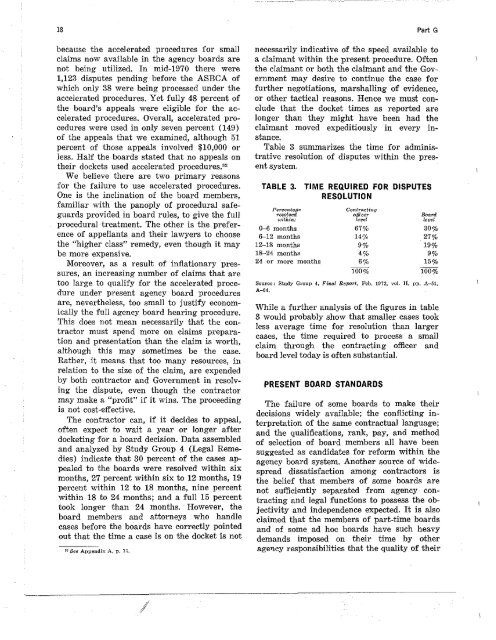Report of the Commission on Government ... - Bayhdolecentral
Report of the Commission on Government ... - Bayhdolecentral
Report of the Commission on Government ... - Bayhdolecentral
Create successful ePaper yourself
Turn your PDF publications into a flip-book with our unique Google optimized e-Paper software.
18 Part G<br />
because <str<strong>on</strong>g>the</str<strong>on</strong>g> accelerated procedures for small<br />
claims now available in <str<strong>on</strong>g>the</str<strong>on</strong>g> agency boards are<br />
not being utilized. In mid-1970 <str<strong>on</strong>g>the</str<strong>on</strong>g>re were<br />
1,123 disputes pending before <str<strong>on</strong>g>the</str<strong>on</strong>g> ASBCA <str<strong>on</strong>g>of</str<strong>on</strong>g><br />
which <strong>on</strong>ly 38 were being processed under <str<strong>on</strong>g>the</str<strong>on</strong>g><br />
accelerated procedures. Yet fully 48 percent <str<strong>on</strong>g>of</str<strong>on</strong>g><br />
<str<strong>on</strong>g>the</str<strong>on</strong>g> board's appeals were eligible for <str<strong>on</strong>g>the</str<strong>on</strong>g> accelerated<br />
procedures. Overall, accelerated procedures<br />
were used in <strong>on</strong>ly seven percent (149)<br />
<str<strong>on</strong>g>of</str<strong>on</strong>g> <str<strong>on</strong>g>the</str<strong>on</strong>g> appeals that we examined, although 51<br />
percent <str<strong>on</strong>g>of</str<strong>on</strong>g> those appeals involved $10,000 or<br />
less. Half <str<strong>on</strong>g>the</str<strong>on</strong>g> boards stated that no appeals <strong>on</strong><br />
<str<strong>on</strong>g>the</str<strong>on</strong>g>ir dockets used accelerated procedures."<br />
We believe <str<strong>on</strong>g>the</str<strong>on</strong>g>re are two primary reas<strong>on</strong>s<br />
for <str<strong>on</strong>g>the</str<strong>on</strong>g> failure to use accelerated procedures.<br />
One is <str<strong>on</strong>g>the</str<strong>on</strong>g> inclinati<strong>on</strong> <str<strong>on</strong>g>of</str<strong>on</strong>g> <str<strong>on</strong>g>the</str<strong>on</strong>g> board members,<br />
familiar with <str<strong>on</strong>g>the</str<strong>on</strong>g> panoply <str<strong>on</strong>g>of</str<strong>on</strong>g> procedural safeguards<br />
provided in board rules, to give <str<strong>on</strong>g>the</str<strong>on</strong>g> full<br />
procedural treatment. The o<str<strong>on</strong>g>the</str<strong>on</strong>g>r is <str<strong>on</strong>g>the</str<strong>on</strong>g> preference<br />
<str<strong>on</strong>g>of</str<strong>on</strong>g> appellants and <str<strong>on</strong>g>the</str<strong>on</strong>g>ir lawyers to choose<br />
<str<strong>on</strong>g>the</str<strong>on</strong>g> "higher class" remedy, even though it may<br />
be more expensive.<br />
Moreover, as a result <str<strong>on</strong>g>of</str<strong>on</strong>g> inflati<strong>on</strong>ary pressures,<br />
an increasing number <str<strong>on</strong>g>of</str<strong>on</strong>g> claims that are<br />
too large to qualify for <str<strong>on</strong>g>the</str<strong>on</strong>g> accelerated procedure<br />
under present agency board procedures<br />
are, never<str<strong>on</strong>g>the</str<strong>on</strong>g>less, too small to justify ec<strong>on</strong>omically<br />
<str<strong>on</strong>g>the</str<strong>on</strong>g> full agency board hearing procedure.<br />
This does not mean necessarily that <str<strong>on</strong>g>the</str<strong>on</strong>g> c<strong>on</strong>tractor<br />
must spend more <strong>on</strong> claims preparati<strong>on</strong><br />
and presentati<strong>on</strong> than <str<strong>on</strong>g>the</str<strong>on</strong>g> claim is worth,<br />
although this may sometimes be <str<strong>on</strong>g>the</str<strong>on</strong>g> case.<br />
Ra<str<strong>on</strong>g>the</str<strong>on</strong>g>r, it means that too many resources, in<br />
relati<strong>on</strong> to <str<strong>on</strong>g>the</str<strong>on</strong>g> size <str<strong>on</strong>g>of</str<strong>on</strong>g> <str<strong>on</strong>g>the</str<strong>on</strong>g> claim, are expended<br />
by both c<strong>on</strong>tractor and <strong>Government</strong> in resolving<br />
<str<strong>on</strong>g>the</str<strong>on</strong>g> dispute, even though <str<strong>on</strong>g>the</str<strong>on</strong>g> c<strong>on</strong>tractor<br />
may make a "pr<str<strong>on</strong>g>of</str<strong>on</strong>g>it" if it wins. The proceeding<br />
is not cost-effective,<br />
The c<strong>on</strong>tractor can, if it decides to appeal,<br />
<str<strong>on</strong>g>of</str<strong>on</strong>g>ten expect to wait a year or l<strong>on</strong>ger after<br />
docketing for a board decisi<strong>on</strong>. Data assembled<br />
and analyzed by Study Group 4 (Legal Remedies)<br />
indicate that 30 percent <str<strong>on</strong>g>of</str<strong>on</strong>g> <str<strong>on</strong>g>the</str<strong>on</strong>g> cases appealed<br />
to <str<strong>on</strong>g>the</str<strong>on</strong>g> boards were resolved within six<br />
m<strong>on</strong>ths, 27 percent within six to 12 m<strong>on</strong>ths, 19<br />
percent within 12 to 18 m<strong>on</strong>ths, nine percent<br />
within 18 to 24 m<strong>on</strong>ths; and a full 15 percent<br />
took l<strong>on</strong>ger than 24 m<strong>on</strong>ths.· However, <str<strong>on</strong>g>the</str<strong>on</strong>g><br />
board members and attorneys who handle<br />
cases before <str<strong>on</strong>g>the</str<strong>on</strong>g> boards have correctly pointed<br />
out that <str<strong>on</strong>g>the</str<strong>on</strong>g> time a case is <strong>on</strong> <str<strong>on</strong>g>the</str<strong>on</strong>g> docket is not<br />
32 See Appendix A, p. 7".<br />
necessarily indicative <str<strong>on</strong>g>of</str<strong>on</strong>g> <str<strong>on</strong>g>the</str<strong>on</strong>g> speed available to<br />
a claimant within <str<strong>on</strong>g>the</str<strong>on</strong>g> present procedure. Often<br />
<str<strong>on</strong>g>the</str<strong>on</strong>g> claimant or both <str<strong>on</strong>g>the</str<strong>on</strong>g> claimant and <str<strong>on</strong>g>the</str<strong>on</strong>g> <strong>Government</strong><br />
may desire to c<strong>on</strong>tinue <str<strong>on</strong>g>the</str<strong>on</strong>g> case for<br />
fur<str<strong>on</strong>g>the</str<strong>on</strong>g>r negotiati<strong>on</strong>s, marshalling <str<strong>on</strong>g>of</str<strong>on</strong>g> evidence,<br />
or o<str<strong>on</strong>g>the</str<strong>on</strong>g>r tactical reas<strong>on</strong>s. Hence we must c<strong>on</strong>clude<br />
that <str<strong>on</strong>g>the</str<strong>on</strong>g> docket times as reported are<br />
l<strong>on</strong>ger than <str<strong>on</strong>g>the</str<strong>on</strong>g>y might have been had <str<strong>on</strong>g>the</str<strong>on</strong>g><br />
claimant moved expeditiously in every instance.<br />
Table 3 summarizes <str<strong>on</strong>g>the</str<strong>on</strong>g> time for administrative<br />
resoluti<strong>on</strong> <str<strong>on</strong>g>of</str<strong>on</strong>g> disputes within <str<strong>on</strong>g>the</str<strong>on</strong>g> present<br />
system.<br />
TABLE 3. TIME REQUIRED FOR DISPUTES<br />
RESOLUTION<br />
Percentage<br />
reeotoea<br />
within:<br />
0-6 m<strong>on</strong>ths<br />
6-12 m<strong>on</strong>ths<br />
12-18 m<strong>on</strong>ths<br />
18-24 m<strong>on</strong>ths<br />
24 or more m<strong>on</strong>ths<br />
C<strong>on</strong>tracting<br />
<str<strong>on</strong>g>of</str<strong>on</strong>g>ficer<br />
level<br />
67%<br />
14%<br />
9%<br />
4%<br />
6%<br />
1000/0<br />
Source: Study Group 4, Pinal <str<strong>on</strong>g>Report</str<strong>on</strong>g>, Feb. 1072, vol. II, DP. A-51,<br />
A-64.<br />
While a fur<str<strong>on</strong>g>the</str<strong>on</strong>g>r analysis <str<strong>on</strong>g>of</str<strong>on</strong>g> <str<strong>on</strong>g>the</str<strong>on</strong>g> figures in table<br />
3 would probably show that smaller cases took<br />
less average time for resoluti<strong>on</strong> than larger<br />
cases, <str<strong>on</strong>g>the</str<strong>on</strong>g> time required to process a small<br />
claim through <str<strong>on</strong>g>the</str<strong>on</strong>g> c<strong>on</strong>tracting <str<strong>on</strong>g>of</str<strong>on</strong>g>ficer and<br />
board level today is <str<strong>on</strong>g>of</str<strong>on</strong>g>ten substantial.<br />
PRESENT BOARD STANDARDS<br />
Board<br />
level<br />
30%<br />
27%<br />
19%<br />
9%<br />
15%<br />
100%<br />
The failure <str<strong>on</strong>g>of</str<strong>on</strong>g> some boards to make <str<strong>on</strong>g>the</str<strong>on</strong>g>ir<br />
decisi<strong>on</strong>s widely available; <str<strong>on</strong>g>the</str<strong>on</strong>g> c<strong>on</strong>flicting interpretati<strong>on</strong><br />
<str<strong>on</strong>g>of</str<strong>on</strong>g> <str<strong>on</strong>g>the</str<strong>on</strong>g> same c<strong>on</strong>tractual language;<br />
and <str<strong>on</strong>g>the</str<strong>on</strong>g> qualificati<strong>on</strong>s, rank, pay, and method<br />
<str<strong>on</strong>g>of</str<strong>on</strong>g> selecti<strong>on</strong> <str<strong>on</strong>g>of</str<strong>on</strong>g> board members all have been<br />
suggested as candidates for reform within <str<strong>on</strong>g>the</str<strong>on</strong>g><br />
agency board system. Ano<str<strong>on</strong>g>the</str<strong>on</strong>g>r source <str<strong>on</strong>g>of</str<strong>on</strong>g> widespread<br />
dissatisfacti<strong>on</strong> am<strong>on</strong>g c<strong>on</strong>tractors is<br />
<str<strong>on</strong>g>the</str<strong>on</strong>g> belief that members <str<strong>on</strong>g>of</str<strong>on</strong>g> some boards are<br />
not sufficiently separated from agency c<strong>on</strong>tracting<br />
and legal functi<strong>on</strong>s to possess <str<strong>on</strong>g>the</str<strong>on</strong>g> objectivity<br />
and independence expected. It is also<br />
claimed that <str<strong>on</strong>g>the</str<strong>on</strong>g> members <str<strong>on</strong>g>of</str<strong>on</strong>g> part-time boards<br />
and <str<strong>on</strong>g>of</str<strong>on</strong>g> some ad hoc boards have such heavy<br />
demands imposed <strong>on</strong> <str<strong>on</strong>g>the</str<strong>on</strong>g>ir time by o<str<strong>on</strong>g>the</str<strong>on</strong>g>r<br />
agency resp<strong>on</strong>sibilities that <str<strong>on</strong>g>the</str<strong>on</strong>g> quality <str<strong>on</strong>g>of</str<strong>on</strong>g> <str<strong>on</strong>g>the</str<strong>on</strong>g>ir
















